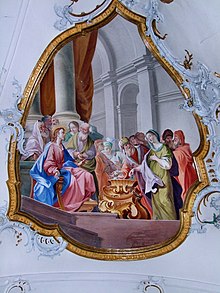Clip Art the Woman Who Put Only 2 Coins in the Temple Offering

A bronze mite, too known as a Lepton (significant small), minted by Alexander Jannaeus, King of Judaea, 103 - 76 B.C.. and still in circulation at the time of Jesus[1]
The lesson of the widow's mite or the widow'southward offering is presented in the Synoptic Gospels (Mark 12:41–44, Luke 21:i–4), in which Jesus is teaching at the Temple in Jerusalem. The Gospel of Marking specifies that two mites (Greek lepta) are together worth a quadrans, the smallest Roman money. A lepton was the smallest and to the lowest degree valuable money in circulation in Judea, worth about six minutes of an boilerplate daily wage.[ii]
Biblical narrative [edit]

"He sat downward opposite the treasury and observed how the crowd put money into the treasury. Many rich people put in large sums. A poor widow too came and put in 2 modest coins worth a few cents. Calling his disciples to himself, he said to them, 'Amen, I say to you, this poor widow put in more all the other contributors to the treasury. For they accept all contributed from their surplus wealth, just she, from her poverty, has contributed all she had, her whole livelihood.'"[3]
[edit]

The traditional interpretation of this story tends to view information technology equally contrasting the acquit of the scribes with that of the widow, and encouraging generous giving; often read with 2 Corinthians 9:seven, "... for God loves a cheerful giver."
All the same, Addison Wright observes that at that place is no indication given of the widow's demeanor or frame of mind. He points out that earlier, in Mark 7:ten-13, Jesus takes to chore the scribes and Pharisees for a hypocrisy that would impoverish parents.[four]
For Moses said, 'Honor your father and your mother,' and 'Whoever curses father or mother shall die.' Nonetheless you lot say, 'If a person says to father or mother, "Whatsoever support you might have had from me is qorban"' (pregnant, defended to God), y'all let him to do nothing more for his father or female parent. Y'all nullify the word of God in favor of your tradition that y'all take handed on. And you lot do many such things."
In the passage immediately prior to Jesus taking a seat opposite the Temple treasury, he is portrayed as condemning religious leaders who feign piety, accept honor from people, and steal from widows. "Beware of the scribes, who like to go around in long robes and accept greetings in the marketplaces, seats of accolade in synagogues, and places of laurels at banquets. They devour the houses of widows and, as a pretext, recite lengthy prayers. They will receive a very astringent condemnation."[5]
The same religious leaders who would reduce widows to poverty likewise encourage them to make pious donations beyond their means. In Wright's opinion, rather than commending the widow'south generosity, Jesus is condemning both the social organisation that renders her poor, and "... the value system that motivates her activity, and he condemns the people who conditioned her to do it."[iv] Elizabeth Struthers Malbon concludes that Wright's interpretation is "more ingenious than convincing."[6]
Quentin Quesnell sees in this account "... a rebuke and rejection of the wrongdoers."[7] Quesnell notes that if Jesus' statement was to be seen every bit an endorsement of the widow's action, it bears none of the usual comments, such every bit "Go, and do likewise."
The account of the Widow's Mite is followed past, "Every bit he was making his way out of the temple area one of his disciples said to him, "Look, instructor, what stones and what buildings!" Jesus said to him, "Do you see these great buildings? There will not be one stone left upon another that will not exist thrown downward."[8]
Wright notes the irony that as the Temple was destroyed in the year seventy, the widow's souvenir was not merely misguided, but for nothing.[iv]
The King James Bible translation [edit]
In Jesus' times in Judea, the small-scale copper coin was chosen a lepton; there was no coin chosen past the English term "mite" at that time. However, there was a mite in the time of the cosmos of the King James Bible, as indeed there had been at the time of earliest mod English translation of the New Testament past William Tyndale in 1525. The denomination was well known in the Southern Netherlands. Both the duke of Brabant and the count of Flanders issued them and they were sometimes imitated in the North. English poet Geoffrey Chaucer refers to the myte in his unfinished poem Anelida and Arcite (c. 1370).[9] Originally, the Brabant mijt (maille in French) was 1/76 stuiver, the Flemish mijt 1/48 stuiver. When the ii areas were united under the dukes of Burgundy and later under the Habsburgs, the charge per unit of the mijt was set up at i/32 stuiver. More important, they were the very smallest copper coins. By 1611, they were no longer minted, but they were notwithstanding in apportionment.
See also [edit]
- Coins of the Bible
- Mite box
- My two cents
- Tithe
References [edit]
- ^ Markowitz, Mike. "CoinWeek Ancient Coin Series: The Widow's Mite". CoinWeek. Retrieved 22 Dec 2016.
- ^ "Mark 12 footnote 83". . New English Translation.
- ^ NAB, Mark 12:41-44
- ^ a b c Wright, Addison Yard. "The Widow'south Mite: Praise or Complaining", The Catholic Biblical Quarterly, 44, 1982, pp.256-265
- ^ NAB, Mark 12:38-xl
- ^ Elizabeth Struthers Malbon, In the Company of Jesus: Characters in Marker's Gospel (Louisville, KY: Westminster John Knox Printing, 2000), 176.
- ^ Quesnell, Quentin. The Mind of Marker, (AnBib 38), Rome Biblical Plant, 1969, 151
- ^ Mark 13:1-ii
- ^ Geoffrey Chaucer, Anelida and Arcite (circa 1370), line 269.
Source: https://en.wikipedia.org/wiki/Lesson_of_the_widow%27s_mite
Post a Comment for "Clip Art the Woman Who Put Only 2 Coins in the Temple Offering"